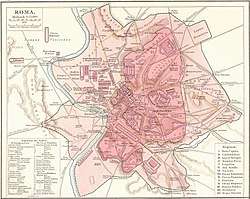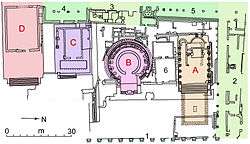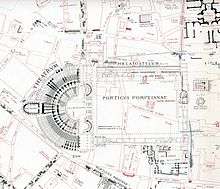Largo di Torre Argentina
 Largo di Torre Argentina, Temple A (to Juturna) in the distance, Temple B in the center, Temple C to the left. In the distant left, the Teatro Argentina | |
 Shown within Rome | |
| Location | Comune di Roma, Lazio, Italy |
|---|---|
| Region | Lazio |
| Type | sanctuary |
| History | |
| Founded | fourth century BC – first century AD |
| Periods | Roman Republic, Roman Empire |
| Cultures | Ancient Rome |
| Site notes | |
| Excavation dates | yes |
| Public access | yes |
| Website | AREA SACRA DI LARGO ARGENTINA |


Largo di Torre Argentina is a square in Rome, Italy, with four Roman Republican temples and the remains of Pompey's Theatre. It is in the ancient Campus Martius.[1]
The name of the square comes from the Torre Argentina, which takes its name from the city of Strasbourg whose Latin name was Argentoratum. In 1503, the Papal Master of Ceremonies Johannes Burckardt, who came from Strasbourg and was known as "Argentinus", built in via del Sudario a palace (now at number 44), called Casa del Burcardo, to which the tower is annexed.
The other tower in the square is not the one giving the name to the place but the medieval Torre del Papito ("Little Pope's Tower"), attributed by tradition to Antipope Anacletus II Pierleoni, allegedly not a tall person.

After Italian unification, it was decided to reconstruct part of Rome (1909), demolishing the zone of Torre Argentina. However, during the demolition work in 1927, the colossal head and arms of a marble statue were discovered. The archeological investigation brought to light the presence of a holy area, dating to the Republican era, with four temples and part of Pompey's Theater.
Julius Caesar was killed in the Curia of the Theatre of Pompey, and the spot he was believed to be assassinated is in the square.[2]
Roman temples


The four temples, originally designated by the letters A, B, C, and D, front onto a paved street, which was reconstructed in the imperial era, after the fire of AD 80. The area was delineated to the North by the Hecatostylum (one-hundred columns porch) and the Baths of Agrippa, and to the South by the buildings related to the Circus Flaminius, to the East by the great porched square of Porticus Minucia Frumentaria, and to the West by the Theatre of Pompey.[3][4]
Temple A was built in the 3rd century BC, and is probably the Temple of Juturna built by Gaius Lutatius Catulus after his victory against the Carthaginians in 241 BC.[5] It was later rebuilt into a church, whose apse is still present.
Temple B, a circular temple (tholos) with six columns remaining, was built by Quintus Lutatius Catulus in 101 BC in fulfillment of his vow at the Battle of Vercellae.[6] The temple (aedes) was devoted to Fortuna Huiusce Diei, "the Fortune of This Day." The colossal statue found during excavations and now kept in the Centrale Montemartini of the Capitoline Museums was the statue of the goddess herself. Only the head, the arms, and the legs were made of marble: the other parts, covered by the dress, were of other materials, probably a wooden frame. This is known as an acrolithic statue.

Temple C is the most ancient of the four, dating back to 4th or 3rd century BC, and was probably devoted to Feronia the ancient Italic goddess of fertility. After the fire of A.D. 80, this temple was restored, and the white and black mosaic of the inner temple cella dates back to this restoration.
Temple D is the largest of the four, dates back to the 2nd century BC with Late Republican restorations, and was devoted to Lares Permarini (Lares who protect sailors), but only a small part of it has been excavated (a street covers the most of it). It was vowed by the praetor, Lucius Aemilius Regillus, while engaged in a naval battle with the fleet of Antiochus the Great in 190 B.C., and dedicated by M. Aemilius Lepidus, when censor, on 22 December, 179.[7] On the doors of the temple was a dedicatory inscription in Saturnian metre.[8] It is recorded as standing in porticu Minucia[9] and therefore its exact site depends on that of the porticus.[10][11]
18th century opera house
The Teatro Argentina was an 18th-century opera house and theatre located in the square. The premieres of many notable operas took place there. They include Gioachino Rossini's The Barber of Seville in 1816 and Giuseppe Verdi's I due Foscari in 1844 and La battaglia di Legnano in 1849.
Cat shelter
Located in Largo Argentina is the Torre Argentina Cat Sanctuary, a no-kill shelter because in Italy there is a no-kill law for homeless cats (of which Rome has many), and is guided by a group of volunteers who sterilize stray cats in Rome.
References
- ↑ Giuseppe Marchetti Longhi (1960). L'area sacra del Largo argentina. Istituto poligrafico dello Stato, Libreria dello Stato.
- ↑ Filippo Coarelli (10 May 2014). Rome and Environs: An Archaeological Guide. University of California Press. pp. 284–. ISBN 978-0-520-95780-0.
- ↑ Giuseppe Marchetti Longhi (1930). L'"area sacra" ed i templi repubblicani del largo Argentina. Libreria di scienze e lettere.
- ↑ L. Richardson, jr (1 October 1992). A New Topographical Dictionary of Ancient Rome. JHU Press. pp. 33–. ISBN 978-0-8018-4300-6.
- ↑ This identification is preferred over the one as Temple of Iuno Curritis, because Ovid (Fasti I) says: "Te quoque lux eadem Turni soror aede recepit/Hic, ubi Virginea Campus obitur aqua", thus posing the temple of Juturna near the Aqua Virgo, which ended at the Baths of Agrippa.
- ↑ G. Marchetti-Longhi, "Gli scavi del Largo Argentina: II Tempio B," BullCom 76 (1956- 58): 45-118
- ↑ Livy XL.52.4; Macrobius I.10.10; Fasti Praenestini ad XI Kal. Ian., CIL I2 pp238, 338; Fast. Ant. ap. NS 1921, 120; HJ 487; Gilb. III.149; Rosch. II.1870‑1871; WR 170.
- ↑ Livy loc. cit.; cf. Baehrens, Frag. poet. Rom. 54‑55.
- ↑ Fast. p316 Praen.
- ↑ AR 1909, 76, p1; RE XII.812.
- ↑ From the Lacus Curtius website)Lares Permarini
External links
| Wikimedia Commons has media related to Largo di Torre Argentina. |
- Area Sacra di Largo Argentina
- Virtual reconstruction in 3D of Largo di Torre Argentina in Ancient Rome
Coordinates: 41°53′43″N 12°28′37″E / 41.89528°N 12.47694°E